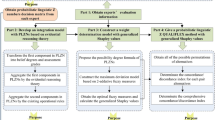Abstract
In this paper, we consider the multiple attribute decision making (MADM) problems, in which the information about attribute weights is partly known and the attribute values are expressed in linguistic labels. We first define the concepts of linguistic positive ideal point, linguistic negative ideal point, and satisfactory degree of alternative. Based on these concepts, we then establish some linear programming models, through which the decision maker interacts with the analyst. Furthermore, we establish a practical interactive procedure for solving the MADM problems considered in this paper. The interactive process can be realized by giving and revising the satisfactory degrees of alternatives till an optimum satisfactory solution is achieved. Finally, a practical example is given to illustrate the developed procedure.
Similar content being viewed by others
Explore related subjects
Discover the latest articles, news and stories from top researchers in related subjects.References
G. Bordogna M. Fedrizzi G. Passi (1997) ArticleTitleA linguistic modeling of consensus in group decision making based on OWA operator IEEE Transactions on Systems, Man, and Cybernetics 27 126–132 Occurrence Handle10.1109/3468.553232
N. Bryson A. Mobolurin (1995) ArticleTitleAn action learning evaluation procedure for multiple criteria decision making problems,” European Journal of Operational Research 96 379–386 Occurrence Handle10.1016/0377-2217(94)00368-8
H. Bustince F. Herrera J. Montero (2006) Fuzzy sets and their extensions: Representation, aggregation and models Physica-Verlag Heidelberg
J. Chen S. Lin (2003) ArticleTitleAn interactive neural network based approach for solving multiple criteria decision making problems Decision Support Systems 36 137–146 Occurrence Handle2025044 Occurrence Handle10.1016/S0167-9236(02)00141-0
E. Herrera-Viedma L. Martinez F. Mata F. Chiclana (2005) ArticleTitleA consensus support system model for group decision-making problems with multigranular linguistic preference relations IEEE Transactions on Fuzzy Systems 13 644–658 Occurrence Handle10.1109/TFUZZ.2005.856561
F. Herrera L. Martinez P.J. Sanchez (2005) ArticleTitleManaging non-homogeneous information in group decision making European Journal of Operational Research 166 115–132 Occurrence Handle1066.90533 Occurrence Handle10.1016/j.ejor.2003.11.031
S.H. Kim Ahn (1999) ArticleTitleInteractive group decision making procedure under incomplete information European Journal of Operational Research 116 498–507 Occurrence Handle1009.90519 Occurrence Handle10.1016/S0377-2217(98)00040-X
S.H. Kim S.H. Choi J.K. Kim (1999) ArticleTitleAn interactive procedure for multiple attribute group decision making with incomplete information: Range-based approach European Journal of Operational Research 118 139–152 Occurrence Handle0946.91006 Occurrence Handle10.1016/S0377-2217(98)00309-9
E.A. Levrat Voisin S. Bombardier J. Bremont (1997) ArticleTitleSubjective evaluation of car seat comfort with fuzzy techniques International Journal of Intelligent Systems 12 891–913 Occurrence Handle10.1002/(SICI)1098-111X(199711/12)12:11/12<891::AID-INT7>3.0.CO;2-S
K.S. Park (2004) ArticleTitleMathematical programming models for characterizing dominance and potential optimality when multicriteria alternative values and weights are simultaneously incomplete. IEEE Transactions on Systems, Man, and Cybernetics-Part A 34 601–614 Occurrence Handle10.1109/TSMCA.2004.832828
K.S. Park S.H. Kim (1997) ArticleTitleTools for interactive multi-attribute decision making with incompletely identified information European Journal of Operational Research 98 111–123 Occurrence Handle0920.90085 Occurrence Handle10.1016/0377-2217(95)00121-2
V. Torra (1996) ArticleTitleNegation functions based semantics for ordered linguistic labels International Journal of Intelligent systems 11 975–988 Occurrence Handle10.1002/(SICI)1098-111X(199611)11:11<975::AID-INT5>3.0.CO;2-W
V. Torra (2001) ArticleTitleAggregation of linguistic labels when semantics is based on antonyms International Journal of Intelligent Systems 16 513–524 Occurrence Handle0990.68156 Occurrence Handle10.1002/int.1021
Z.S. Xu (2002) ArticleTitleInteractive method based on alternative achievement scale and alternative comprehensive scale for multiple attribute decision making problems Control and Decision 17 435–438
Z.S. Xu (2004a) Uncertain multiple attribute decision making: Methods and applications Tsinghua University Press Beijing
Z.S. Xu (2004b) ArticleTitleA method based on linguistic aggregation operators for group decision making with linguistic preference relations Information Sciences 166 19–30 Occurrence Handle10.1016/j.ins.2003.10.006
Z.S. Xu (2005) ArticleTitleDeviation measures of linguistic preference relations in group decision making Omega 33 249–254 Occurrence Handle10.1016/j.omega.2004.04.008
Xu Z.S., Chen J. (2006). An interactive method for fuzzy multiple attribute group decision making. Information Sciences (in press)
R.R. Yager (1992) ArticleTitleApplications and extensions of OWA aggregations International Journal of Man- Machine Studied 37 103–132 Occurrence Handle10.1016/0020-7373(92)90093-Z
R.R. Yager (1995) ArticleTitleAn approach to ordinal decision making International Journal of Approximate Reasoning 12 237–261 Occurrence Handle0870.68137 Occurrence Handle1327857 Occurrence Handle10.1016/0888-613X(94)00035-2
R.R. Yager (1996) ArticleTitleQuantifier guided aggregation using OWA operators International Journal of Intelligent Systems 11 49–73 Occurrence Handle10.1002/(SICI)1098-111X(199601)11:1<49::AID-INT3>3.0.CO;2-Z
L.A. Zadeh J. Kacprzyk (1999) Computing with Words in Information/Intelligent Systems-Part 1: Foundations: Part 2: Applications vol Physica-Verlag Heidelberg, Germany
H.J. Zimmermann P. Zysno (1980) ArticleTitleLatent connectives in human decision making Fuzzy Sets and Systems 4 37–51 Occurrence Handle0435.90009 Occurrence Handle10.1016/0165-0114(80)90062-7
Author information
Authors and Affiliations
Corresponding author
Rights and permissions
About this article
Cite this article
Xu, Z. An interactive procedure for linguistic multiple attribute decision making with incomplete weight information. Fuzzy Optim Decis Making 6, 17–27 (2007). https://doi.org/10.1007/s10700-006-0022-z
Issue Date:
DOI: https://doi.org/10.1007/s10700-006-0022-z



